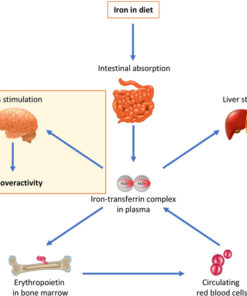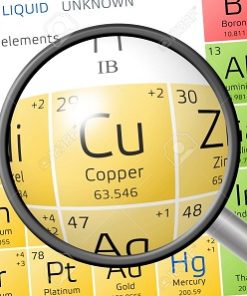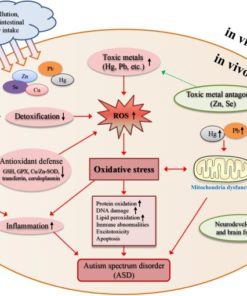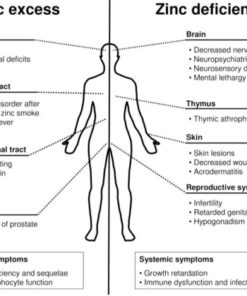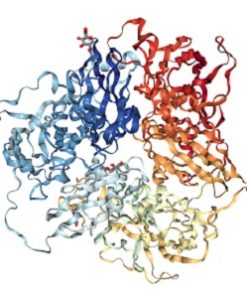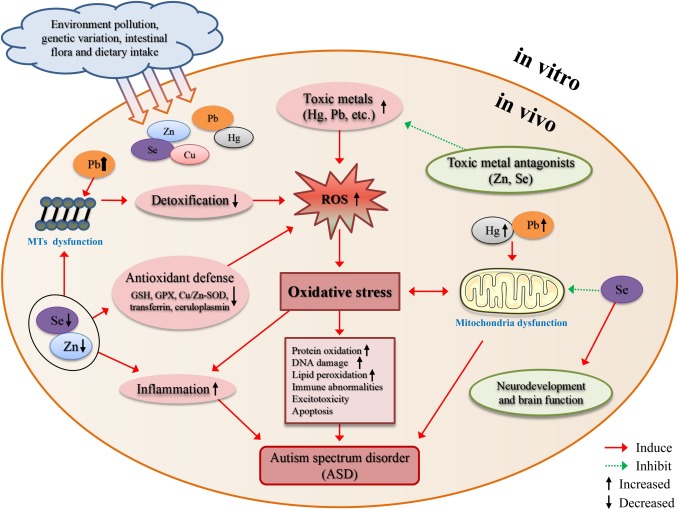
Autism Spectrum Disorder
Autism Spectrum Disorder (ASD) is a complex neurodevelopmental disorder that affects communication, social interaction, and behavior. It is a multifaceted disorder that also includes a significant degree of methylation imbalance. In recent years, there has been a growing interest in the relationship between copper overload and ASD. Studies suggest that many children with ASD may have suffered from oxidative stress due to copper overload.
Copper Toxicity in Autism; Factors That May Lead to Symptoms of Copper Overload
Copper is an essential mineral that plays a crucial role in various bodily functions, including the immune system, the formation of red blood cells, and the maintenance of healthy bones and connective tissues. However, excessive amounts of copper in the body can lead to oxidative stress and damage to cells, proteins, and DNA. In recent years, researchers have suggested a possible link between copper overload and autism spectrum disorders (ASD), a group of neurodevelopmental disorders characterized by impairments in social interaction, communication, and repetitive behaviors. This post will explore the mechanisms through which copper overload may contribute to the development of ASD, including the role of zinc and ceruloplasmin, estrogen, vaccines, genetics, diet, and digestive integrity. It will also discuss the impact of elevated copper levels during pregnancy and breastfeeding on the risk of ASD in offspring.
Copper Levels in Pregnancy and Post Partum While Breast Feeding
In addition, it is important for pregnant women to ensure adequate zinc intake to prevent excessive imbalances in the developing fetus. Postpartum, copper overload should be considered as a preventive measure, especially in breastfeeding women with postpartum depression. An imbalance in copper and zinc in breast milk can transfer to the child, predisposing them to copper overload and oxidative stress. This, when combined with metal- and oxidant-containing vaccines and/or a genetic predisposition to elevated copper in the neonate, may lead to a health breakdown and significant behavioral expression of ASD. Therefore, management of children and mothers preceding exposure to vaccines should focus on antioxidant therapy and proper dietary considerations. Post-vaccination, children may also benefit from antioxidants to reduce the effects of possible metals and oxidants.
Estrogen Dominance in Pregnancy and Autism
Estrogen is a hormone that plays a critical role in the development and functioning of the female reproductive system, but it can also have significant effects on the brain and behavior. Recent studies have suggested that there may be an association between elevated levels of estrogen and the development of autism in children. While more research is needed to fully understand this connection, it has been hypothesized that estrogen may interfere with the development of the brain during critical periods of growth and maturation, leading to changes in the way that the brain functions and processes information.
Estrogen has been shown to increase metallothionein production in some tissues, which may lead to an increase in copper binding to metallothionein and a reduction in free copper. However, in other tissues such as the liver, estrogen can actually decrease metallothionein production and increase free copper levels. Additionally, estrogen can increase the amount of copper that is transported from the gut into the bloodstream, leading to an overall increase in copper levels in the body. So while estrogen may have some positive effects on copper regulation through metallothionein production, it can also have negative effects that lead to copper overload. The exact mechanisms are complex and may depend on various factors such as the type of tissue and the individual's overall health status.
Effect of Vaccines in Autism; Metals and Other Inflammatory Agents
Some researchers suggest that environmental factors, such as vaccines and toxins, may contribute to copper overload in children with ASD. Mercury-containing vaccines, in particular, have been linked to ASD in some studies. Additionally, other environmental toxins, such as lead, may contribute to copper overload and oxidative stress.
Thimerosal, while used to a lesser degree in vaccines than in past years, is still used as a preservative, to prevent contamination by bacteria and fungi. It contains ethyl mercury, a type of organic mercury that is different from the methylmercury found in fish. While it has been argued thimerosal is safe in vaccines, concerns have been raised about its potential toxicity due to the presence of mercury. In addition to thimerosal, other vaccine adjuvants may contain oxidizing agents such as aluminum, which are used to exaggerate the immune response and boost the impact of the vaccines. The flu vaccine is available in both thimerosal-containing and thimerosal-free formulations.
The neurotoxicity of thimerosal a mercury-containing compound used as a preservative in vaccines was evaluated in a publication by Dorea, JG. The scientific evidence suggests that Thimerosal, even at low doses, may have neurotoxic effects and may be linked to adverse neurodevelopmental outcomes. While observational population studies have revealed uncertainties related to neurological effects, the evidence indicates a link between Thimerosal exposure and adverse neurodevelopmental outcomes such as tic disorder. Therefore, the author argues that Thimerosal-free vaccine options should be made available in developing countries to mitigate the risk of exposing young children to Thimerosal and reduce the incidence of neurodevelopmental disorders.
Some studies have suggested that thimerosal exposure may affect copper metabolism, as both mercury and copper can bind to sulfhydryl groups on proteins and interfere with their function. Additionally, thimerosal-induced oxidative stress may lead to increased production of ceruloplasmin, which can bind to copper and potentially contribute to copper overload. However, further research is needed to fully understand the relationship between thimerosal, mercury, and copper toxicity.
In addition to thimerosal, aluminum and other elements present in vaccines may contribute to oxidative stress in children. Aluminum, a commonly used vaccine adjuvant, has been shown to increase the production of reactive oxygen species (ROS) and decrease antioxidant levels, leading to oxidative stress. Mercury, which was previously used as a preservative in some vaccines, has also been shown to cause oxidative stress in various tissues. Although thimerosal is no longer used in most vaccines, some vaccines may still contain trace amounts of mercury due to the manufacturing process or the use of certain vaccine ingredients. Formaldehyde and polysorbate 80, which are used as stabilizers and emulsifiers, respectively, are also potential sources of oxidative stress in vaccines.
Given the potential risks associated with exposure to these elements in vaccines, thimerosal-free vaccine options should be made available not only in developing countries but also in the US. While vaccines are an important tool for preventing infectious diseases, repeated exposure to metals and oxidants in vaccines can tip the scale towards the development of neurodegenerative conditions. Therefore, it is important to continue researching the potential adverse effects of vaccine ingredients and to prioritize the development of safer and more effective vaccine options.
Summary of research link:
The causes of autism and neurodevelopmental disorders are not fully understood, but it is believed that genetic and environmental risk factors may play a role. While some studies have failed to find a correlation between mercury exposure through thimerosal, a preservative used in vaccines, and the risk of autism, recent research has shown that autistic children have had higher mercury exposure during pregnancy due to maternal dental amalgam and thimerosal-containing immunoglobulin shots. It has been suggested that children with autism may have a decreased detoxification capacity due to genetic polymorphism, and that mercury and thimerosal may inhibit biochemical steps necessary for brain development, attention and production of glutathione, an important antioxidative and detoxifying agent. Promising treatments of autism involve detoxification of mercury and supplementation of deficient metabolite.
Genetic Factors Affecting Copper and Ceruloplasmin Levels in Autism
Mutations in the ATP7A and ATP7B genes can cause copper accumulation in various tissues and result in conditions such as Menkes disease and Wilson disease. These genes encode proteins involved in copper transport and metabolism, and mutations can affect their function. Other genetic factors, such as polymorphisms in genes related to copper homeostasis, may also contribute to individual differences in copper and ceruloplasmin levels. Understanding the genetic factors that contribute to copper and ceruloplasmin metabolism can be important for identifying individuals at risk for copper-related conditions and developing personalized approaches to prevention and treatment.
Role of Digestive Health and Diet in Autism
Glutamate is an excitatory neurotransmitter that is naturally found in the body and is important for normal brain function. However, when consumed in large amounts or in the form of MSG, it can overstimulate nerve cells and cause damage. MSG is commonly added to processed foods, such as snacks, soups, and frozen meals, to enhance their flavor. Although it is generally recognized as safe by the FDA, many people report experiencing symptoms such as headaches, nausea, and digestive issues after consuming foods that contain MSG.
Processed foods, in general, tend to be high in sugar, unhealthy fats, and refined carbohydrates, and low in fiber and other important nutrients. These types of foods can promote the growth of harmful gut bacteria, leading to dysbiosis and inflammation. In addition, they often contain additives and preservatives, such as sodium nitrate and sodium benzoate, which have been linked to increased inflammation and oxidative stress.
When consumed in excess, these inflammatory foods can contribute to leaky gut and leaky blood vessels, which can allow harmful substances such as bacteria and toxins to pass through the gut lining and into the bloodstream. This can lead to the formation of neurotoxic immune complexes, which can trigger an immune response and further exacerbate inflammation.
To support a healthy gut microbiome and reduce inflammation, it is important to focus on whole, unprocessed foods, including a modest amount of fruits and modest amount of grains and carbohydrates, with a higher amount of vegetables, animal derived saturated fats and proteins. Additionally, limiting consumption of added sugars, refined carbohydrates, and processed foods can help to reduce inflammation and promote optimal digestive health.
Low levels of copper and ceruloplasmin can also contribute to oxidative stress and may be associated with autism. Ceruloplasmin is an enzyme that plays a role in copper transport and regulation, as well as antioxidant defense. In individuals with autism, low levels of ceruloplasmin have been observed, suggesting impaired copper metabolism and reduced antioxidant capacity. This can result in increased oxidative stress and inflammation in the brain, which has been proposed as a potential mechanism underlying autism. Additionally, low copper levels have been linked to impaired function of neurotransmitters involved in social behavior and cognition, which are often affected in individuals with autism. Therefore, optimizing copper and ceruloplasmin status by testing and through diet and supplementation may be an important factor in addressing oxidative stress and related symptoms in individuals with autism.
Testing for Copper Overload and other Factors that May Contribute to Autism Spectrum Disorder
Second Opinion Physician offers testing for copper overload using the Walsh Approach to determine the status in young children and adults, as copper overload is believed to contribute significantly to autism. There is also evidence that undermethylation plays a role, and the lab offers testing panels for Copper Overload, Histamine Methylation, Plasma Methylation, and Comprehensive Biotype for all ages. The functional medicine physician provides consultations to interpret the results and create a personalized supplement strategy to correct imbalances.
Understanding Copper Overload
Testing for Copper Overload
Other Single Item Tests
All Cognoscopy Labs
All Cognoscopy Labs
All Cognoscopy Labs
Walsh Approach Test Panels

